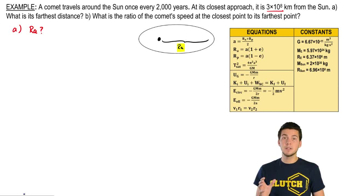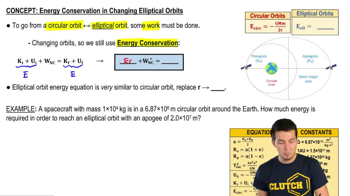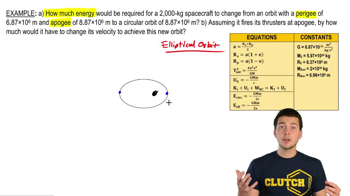8. Centripetal Forces & Gravitation
Energy of Elliptical Orbits
Practice this topic
- Multiple Choice
Pluto travels in a fairly elliptical orbit around the Sun. At its closest distance of km, its orbital speed is 6.12 km/s. At its farthest, its orbital speed reduces to just 3.71 km/s. How far is it from the Sun at this point (in km)?
238views2rank - Multiple Choice
A comet is in a highly elliptical orbit around the Sun with a period of 2400 years. If this comet has a mass of approximately kg, what is the total energy of its orbit?
207views1rank - Textbook Question
Comets move around the sun in very elliptical orbits. At its closet approach, in 1986, Comet Halley was 8.79 x 10⁷ km from the sun and moving with a speed of 54.6 km/s. What was the comet’s speed when it crossed Neptune’s orbit in 2006?
219views - Textbook Question
A 55,000 kg space capsule is in a 28,000-km-diameter circular orbit around the moon. A brief but intense firing of its engine in the forward direction suddenly decreases its speed by 50%. This causes the space capsule to go into an elliptical orbit. What are the space capsule’s (a) maximum and (b) minimum distances from the center of the moon in its new orbit?
Hint: You will need to use two conservation laws.
190views - Textbook Question
Let’s look in more detail at how a satellite is moved from one circular orbit to another. FIGURE CP13.70 shows two circular orbits, of radii r₁ and r₂ , and an elliptical orbit that connects them. Points 1 and 2 are at the ends of the semimajor axis of the ellipse. (b) Consider a 1000 kg communications satellite that needs to be boosted from an orbit 300 km above the earth to a geosynchronous orbit 35,900 km above the earth. Find the velocity v'₁ on the inner circular orbit and the velocity v'₁ at the low point on the elliptical orbit that spans the two circular orbits.
154views




